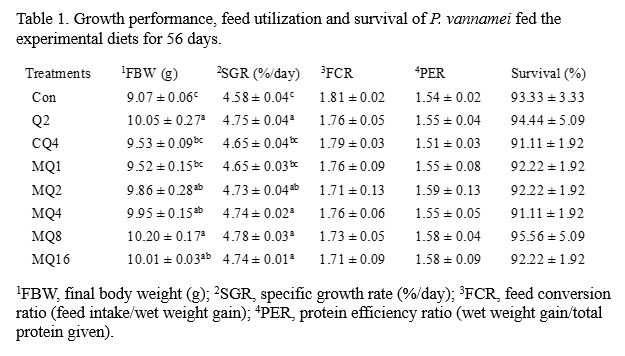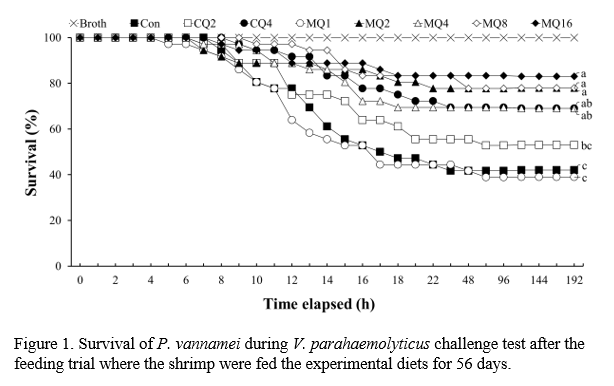A COMPARATIVE STUDY OF UTILIZATION OF DIETARY COENZYME Q10 AND ITS MICELLAR ENCAPSULATION FOR PACIFIC WHITE SHRIMP Penaeus vannamei
Introduction
Coenzyme Q10 (CoQ10) is a hydrophobic antioxidant that has gained attention as a functional feed additive in aquaculture. Micellar encapsulation is an effective technique to enhance intestinal absorption of hydrophobic compounds such as CoQ10. Despite its potential, very limited information is available regarding the comparative effects of dietary CoQ10 and its micellar form for the shrimp. This study was conducted to evaluate the effects of dietary supplementation of CoQ10 and micellar CoQ10 (MQ10) on growth performance, feed utilization, immune response, antioxidant capacity and resistance to acute hepatopancreatic necrosis disease in the shrimp.
Material and methods
A control diet (Con) was formulated to contain 15% fish meal (anchovy and tuna byproduct) and 4% cod liver oil. The experimental diets included the Con diet supplemented with CoQ10 at 20 and 40 mg/kg (designated as CQ2 and CQ4, respectively), as well as with MQ10 at levels of 10, 20, 40, 80 and 160 mg/kg (designated as MQ1, MQ2, MQ4, MQ8 and MQ16, respectively). Total 720 shrimp (0.70 ± 0.01 g) were randomly stocked into 24 tanks (240 L) with 30 shrimp per tank. Triplicate groups of the shrimp were fed one of the diets six times daily for 56 days. After the feeding trial, Vibrio parahaemolyticus suspension was added to each tank to achieve a final bacterial concentration of 3.0×105 CFU/mL for a challenge test. The challenge test was carried out for 8 days (192 h) monitoring the mortality hourly.
Results
Final body weight and specific growth rate were significantly higher in shrimp fed CQ2, MQ2, MQ4, MQ8 and MQ16 diet than in shrimp fed Con diet (Table. 1). Feed conversion ratio, protein efficiency ratio and survival were not significantly affected by dietary administration of CoQ10 and MQ10. Digestive enzyme activities (trypsin, chymotrypsin, and lipase) were significantly increased in MQ8 than in all other groups and Con group. Lysozyme activity was significantly higher in all MQ10 supplemented groups than in Con group. Phagocytosis activity was significantly higher in shrimp fed CQ2, CQ4, MQ8 and MQ16 diets than in shrimp fed Con diet. Antioxidant activities (superoxide dismutase and catalase) were significantly improved in CQ2, CQ4 and all MQ10 groups than in Con group. During the V. parahaemolyticus challenge test, Con group showed significantly lower survival compared to CQ4, MQ2, MQ4, MQ8 and MQ16 groups.
Conclusion
Dietary supplementation of CoQ10 had positive effects on non-specific immunity, antioxidant capacity and disease resistance of P. vannamei. Micellar encapsulation enhanced the absorption and utilization of CoQ10 in the shrimp, suggesting that MQ10 is a promising delivery form. These findings indicate that CoQ10 is a potential natural feed additive for the improvement of the shrimp health and disease resistance.

